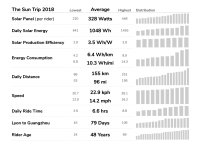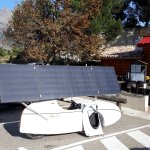solarEbike
100 W
My last post offered some conclusions about building a solar bike for casual touring but what does the data say about strategies for winning The Sun Trip 2020?
Max out your solar array
For single riders, the 2018 rules allowed up to 450 solar watts deployed while riding. The 2020 rules no longer specify a wattage limit and only impose a 2.50 m² limit. You'll need to max this out using a custom solar array made with Sunpower Gen III bin Le1 Maxeon cells at 3.63 watts/bare cell. At 125mm x 125mm per cell plus 1mm gap between cells, you can build 2 panels consisting of 6 x 13 cells for a total of 2.48 m² and a whopping 566 watts (excluding encapsulation losses).
Your panel voltage will be too high for a boost charge controller with your nominal 36V or 48V battery so you might want to split into 4 panels. Also, the 2020 rules dropped the words "Solar cells surface is measured from cell to cell, not counting the outer panel borders but including the gaps between cells" so you might want to check with the organizers to get some clarification about how they handle the border measurements.
Use a tilt tracker
Forget what I said about solar tilt not being worth the trouble for casual touring. The difference between 1st and 2nd place in The Sun Trip 2018 was 13%. You'll need the additional 13% a tilt mechanism can provide.
Don't ride a tandem
While there are some theoretical weight savings and aero advantages of two riders sharing the same vehicle, the solar allowance per rider is much lower for tandems. Consider that not a single tandem team made it to Guangzhou in the final rankings with the "100% solar" badge next to its name... possibly because none of them were participating as if they were in a race.
Pedal your butt off
Extrapolating from the #2 ranked rider's 8 hours and 46 minutes per day, you'll need to average 10 hours of riding per day if you want to win. No time to stop and smell the roses. Also, don't bother with carrying the additional 1.50 m² of solar panels you're allowed to deploy only when stopped. You won't be standing still long enough during daylight hours to offset the extra weight.
Pace yourself
Mickaël and Stéphane had almost identical vehicles (short wheel base recumbents with both solar roof and solar trailer) and covered the same total distance along a similar route. However, Mickaël finished 5 days faster despite having 2.6% less solar energy per day. He covered more distance per day not by riding faster and harder but by riding slower and longer. Using the Grin Motor Simulator, I get about 5% more range by riding at 24.8 kph instead of 26.1 kph. If we pretend all other factors are equal, the remaining extra daily km come from additional human Wh from that extra hour of pedaling.

Max out your solar array
For single riders, the 2018 rules allowed up to 450 solar watts deployed while riding. The 2020 rules no longer specify a wattage limit and only impose a 2.50 m² limit. You'll need to max this out using a custom solar array made with Sunpower Gen III bin Le1 Maxeon cells at 3.63 watts/bare cell. At 125mm x 125mm per cell plus 1mm gap between cells, you can build 2 panels consisting of 6 x 13 cells for a total of 2.48 m² and a whopping 566 watts (excluding encapsulation losses).
Your panel voltage will be too high for a boost charge controller with your nominal 36V or 48V battery so you might want to split into 4 panels. Also, the 2020 rules dropped the words "Solar cells surface is measured from cell to cell, not counting the outer panel borders but including the gaps between cells" so you might want to check with the organizers to get some clarification about how they handle the border measurements.
Use a tilt tracker
Forget what I said about solar tilt not being worth the trouble for casual touring. The difference between 1st and 2nd place in The Sun Trip 2018 was 13%. You'll need the additional 13% a tilt mechanism can provide.
Don't ride a tandem
While there are some theoretical weight savings and aero advantages of two riders sharing the same vehicle, the solar allowance per rider is much lower for tandems. Consider that not a single tandem team made it to Guangzhou in the final rankings with the "100% solar" badge next to its name... possibly because none of them were participating as if they were in a race.
Pedal your butt off
Extrapolating from the #2 ranked rider's 8 hours and 46 minutes per day, you'll need to average 10 hours of riding per day if you want to win. No time to stop and smell the roses. Also, don't bother with carrying the additional 1.50 m² of solar panels you're allowed to deploy only when stopped. You won't be standing still long enough during daylight hours to offset the extra weight.
Pace yourself
Mickaël and Stéphane had almost identical vehicles (short wheel base recumbents with both solar roof and solar trailer) and covered the same total distance along a similar route. However, Mickaël finished 5 days faster despite having 2.6% less solar energy per day. He covered more distance per day not by riding faster and harder but by riding slower and longer. Using the Grin Motor Simulator, I get about 5% more range by riding at 24.8 kph instead of 26.1 kph. If we pretend all other factors are equal, the remaining extra daily km come from additional human Wh from that extra hour of pedaling.




